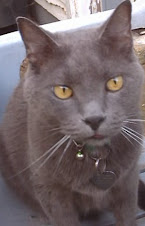Fabric
I realize this is a lesson about adding fabric to our altered books, but I thought you might enjoy a quick lesson on surface design, or coloring your own fabric.
For those of you who actually dye your own fabric, you know all about such chemicals and words like Synthrapol, a product you must use to remove any dirt and oil in new fabric prior to dyeing, it is also used as an afterwash. Then there is soda ash, a product which "fixes" your dye such that there will be less bleeding of the fabric when it is washed. Next there is Urea, a product that sounds like something Bleubeard would deposit in his sandbox, but is actually used to dissolve the dye.
Let's not forget about polyester. It has its own set of chemical ingredients, such as Lissopal D paste, used as a pre-wash, Lyogen, Sandozen, and Acetic Acid.
Then there are the dyes, which include hot and cold reactive dyes, mainly differentiated by their ability to confuse the buyer. All dyes are labeled this way, but the label is very confusing. A hot reactive dye requires boiling at 100 degrees C (212 F) for the bond between fabric and dye to occur. A cold reactive dye doesn't need to be boiled, but it still needs between 65 and 70 degrees C (149 to 158 degrees F) for the dye process to occur.
Some believe the hot process is easier and the fabric is more colorfast, but the cold process is actually what clothing manufacturers use to dye their fabric. Either process can be used to dye any fabric that starts out as a plant, such as cotton, linen, bamboo, or hemp. Popular fabrics made from these plants include denim, twill, calico, muslin, corduroy, and cheesecloth.
The dyes are also broken into fiber-reactive and acid dyes. Fiber-reactive dyes (Procion is one brand) are good dyes for any kind of non-protein fiber that will take dye (cotton, linen, linen-cotton blends, rayon). These work well in cold water, are nice and bright, and are color-fast. Soda ash (sodium carbonate) is used to raise the acidity of the dye bath and "lock" the dye onto the fiber. Soda ash, which must be used with fiber reactive dyes, is caustic. While plant-based fibers can take the harshness, it can make protein-based fibers harsh and brittle. Fiber-reactive dyes are easier for the fabric to absorb, causing less time and water when rinsing the dye from the fabric. Acid dyes (Jacquard is one brand) are the preferred dyes for protein-based fibers (wool, silk, camel hair, etc.). These are fibers you manipulate at the cellular level. Whether you have chosen hot or cold, acid or fiber-reactive, the dye must be measured using scales and various charts. (This information was obtained from various web sites, including http://www.essortment.com/dye-fabrics-home.htm, which claims cold water dyeing produces only pastels, never rich colors, http://www.ehow.com/how_4471851_dye-fabric.html, which includes ideas for making you own dyes, such as with onion skins, and http://www.ritdye.com/ which talks about ombre dyeing, dyeing on paper, and low water immersion dyeing).
Add to all those caustic chemicals there's the mess. Either process requires lots of newspapers, plastic bags, rubber gloves (the kind you use when washing hot dishes), a different wooden or plastic spoon to stir each dye color, and a disposable container to mix each dye color.
One way to use dye is a surface design technique using a product called sodium alginate, which thickens the dye and allows you to use/apply it like paint.
You can also use Rit Dye, which is a hot disperse dye, but all the chemicals are already in the dye powder or liquid. You can use Rit in large quantities where you stir the fabric and dye in a pot on the stove, or throw the dye in your washing machine, set on "hot water," add fabric and let your machine take over. Of course, you must reset the machine several times. There are also charts for this. Or, you can do something called "low water immersion" dyeing, where you add a small amount of water, a certain amount of dye, and your fabric to a microwave safe container and heat for two minutes. I've actually done this before and it was quite easy. Dyeing paper requires either full strength liquid dye, if you like bright colors, or diluted liquid or powder dyes, painted onto the paper, then placed in the microwave for one minute. There are tables and charts for just about anything on the Rit website including how to make this year's Pantone color, Tangerine Tango.
In order to dye anything, you should prewash your fabric in Synthanol or buy PFD fabric, which stands for Prepared For Dyeing. You buy this fabric at your local fabric store or on the internet. Even if you are using PDF, expect the fabric to shrink at least 10% in the length and about 1% in the width once it has been dyed.
Now if all that sounds like more than you ever wanted to know about dyeing fabric, and if it sounds like the processes are too complicated, I happen to agree with you. As a result, I went looking for a better way of dyeing fabric for art. Although I felt I should at least cover dyeing basics as the PROS would do it, here is MY way of dyeing fabric for any art project that does NOT include clothing. Have I mentioned how I like to find simple safe ways of doing things? To my knowledge, I am the only person currently dyeing art quilt and altered art fabric this way, and now you can, too.
Tulle and cheesecloth
Any stamping INK, including DYE, DISTRESS, and SOLVENT inks, but NOT PIGMENT
91% Isopropyl Alcohol (used only with SOLVENT based ink, like Staz-on, which I will be using)
Water (not shown, but used with DYE and DISTRESS inks, but NEVER SOLVENT inks)
Brushes (I prefer foam, although they swell when the alcohol hits them)
Cup for mixing INK
Fabric of your choice (I like to use old bed sheets from the thrift store or my linen closet)
I plan to demonstrate using Staz-on SOLVENT ink and Isopropyl Alcohol. If you are using DYE or DISTRESS ink, substitute your ink for Staz-on, and water for the alcohol. Everything else is the same. I want to repeat that you must use alcohol with any solvent based ink, including Staz-on. Water will simply not work! And it should probably go without saying (but I'm going to anyway), use water with your dye based inks, since alcohol will not work!
As many of you who religiously read my blog know, the fabric above is NOT something I would ever use. But, it is perfect for altered art. I have no idea where I got it, since I asked my art friend Kathy and she said she had not given it to me.
Now that some of you have decided to try my way of dyeing fabric, allow me to show you one of the ways I attach fabric to my book pages.
Adding fabric to your AB:
Once you have colored your fabric, iron flat to get out the wrinkles and assure that the background fabric is completely dry. When dry, back the fabric using Wonder Under, a Pellon brand product you iron to your fabric that works like glue, but doesn’t stiffen the fabric like regular glue does. Decorate as you would a piece of background paper, using rubber stamps, stencils, etc. The following spreads were created in my Hands AB.
Iron
Various fabric
Craft sheet
Heat bond (stronger than Wonder Under)Now you have a choice. You can cut the background to the approximate size of your book page(s), then sew all the pieces together using a sewing machine or by hand. Or, you can back the remainder of the fabric with Wonder Under and glue your pieces together. You can also use a fabric glue, but I’ve never used it to attach a large piece of fabric to a book page, so I’m not sure how effective it is.
If you have not sewn your fabric together, you can use a permanent marker such as a Sharpie to draw "faux" thread lines on the piece. I've also seen stickers and rub-ons that give the appearance of thread lines.
Now for the surprise. This shows how to use your fabric and your polymer clay in one spread.
Decorate your page to coordinate with your fabric, then wrap the fabric around the cardstock and tie the ribbon. Apply glue only in the area of the cardstock and attach to your decorated page. You should be able to feel the cardstock through the fabric, which will help when adhering the ribbon and the "package" to the page.
Here are some of the other ways to use fabric:
1. Iron a piece of fabric wrong side to the shiny side of freezer paper. Cut to 8.5" X 11" (or A4 size for European printers), compose a page of images from your computer, and run through your printer. Remove the fabric from the freezer paper by pulling the fabric away. The freezer paper can be used at least three times.
2. Use tulle to partially hide or diffuse an image. Adhere the tulle over the image using brads or eyelets.
3. Cut the front of a pair of jeans with the zipper, waistband, and pockets intact. Iron a heavy bonding material to the jean fabric, then back with a coordinating fabric. Apply any image behind the zipper (as you did in lesson 8), and adhere (iron) to the page. Place coordinating tags in the pockets.
4. Consider using Tyvek or Viva brand paper towels in place of fabric. They both feel and dye like fabric, and if you have a sewing machine, they even sew like fabric.
5. Glue a magazine image to one side of a page. Make sure the image has only a few details. Glue a relatively sheer piece of fabric over the magazine image. Using a black Sharpie, color in the details. Frame the image using a ruler and the Sharpie.
6. Make pockets using fabric. You will need a stabilizer for the pocket, but if you don't have any, you can use paper towels or even several layers of butcher paper.
7. If you have good red or gray rubber stamps (don't use the acrylic ones), you can stamp on velvet. Spritz the velvet with water, lay over the rubber stamp pile side down, then place your iron over the rubber and velvet. Keep steam holes away from the image because they will become part of the image. Don't move the iron around, and only leave the iron on for about 10 seconds.
8. Cut images from colorful fabric and use them as your focal image. Be sure to use sharp fabric scissors, because it really shows when the images aren't cut precisely.
Suggested supplies you will need for Lesson 18:
Gel medium
Packing tape (also called package tape, clear tape, label protector tape)
Alternately,
Clear contact paper (which is sticky backed)
Magazine images
Ink jet copies
Toner copies (from your Lazar printer or the copy store)
Orange degreaser
CitraSolve
Ink jet transparencies
Computer images and printer
I suspect you will not have all these supplies. That is why I'll be offering a plethora of transfer methods. Pick one or more to play with, but DO NOT go out and buy a bunch of supplies.
Homework (totally optional, but always appreciated):
Create a spread using fabric in some way. It can be part or all of a book page or spread, or an embellishment. I have tried to show several examples that you can use for inspiration.
It's share time!
It’s time to show us your interpretation of Lesson 17, where you played with polymer clay. I realize these posts are out of order (since we are now learning Lesson 16), but you should remember that was my decision. You have two weeks to post Lesson 17, but I suspect those of you who played with polymer clay (or maybe air dry clay) are ready. As always, please be sure the link is to the specific post or posts, not to your blog in general. You may also post ANY previous lesson here. Just add the lesson number after your name, please.














.jpg)




































































.JPG)

























18 thoughtful remarks:
Truly gorgeous altered book spreads and a terrific tutorial! I must admit my favorite fabric is the soft mauve/lavender, but the 'surprise' page is beautiful too. And so cool that you showed how 'fabric you don't particularly like' can still be utilized. you will make 'altered book lovers' out of all of us yet!
Sorry no homework this week as all the clay stuff I saw was the oven sort and I wasn't prepared to subject my oven to that, let alone my nose - LOL. Had a quick skim through this lesson on fabric but there was so much I need to come back when I am feeling better. Thanks Elizabeth. BJ
Many thanks for all the effort and time you put into these lessons. Such wonderful and informative posts.
This is the most amazing tutorial, a bonanza of information. Thanks for visiting today...FYI the lines in the magazine image I did by scraping tempura paint over the image. Alot of it soaks right into the magazine paper and then I scrape most of the paint off, leaving the line effect. It came out in a way I didn't expect but worked really great with the instagram filter(nashville). I will see if I can duplicate it again. I don't know if it would work on other magazine images, bit I might try it and see. Off to work on a card swap deck. Thanks for all the great info.
xox
LOVE the fabric bead idea, never, ever woulf have thought of that, and I am so going to try it! Planning on adding some fabric to a wall sign too, so this gives me lots of ideas to think about! ((hugs and kisses to Bluebeard )) waving hi from the hills of North Carolina:)
Another comprehensive tutorial, Elizabeth. You are a wonderful teacher. I shall get my polymer clay Thank YOU!
WOW! Another impressive tutorial! I think I will start with the fabric beads. I've always wanted to make some. Patsy from
HeARTworks and
papemelroti
this is such a complete tutorial and so many bits of it and your others are wonderful to try out all on their own!! you give new meaning to "two-fer" and also, Gracie was so glad to hear your enJOYment of her photos. as each day of 2012 passes I am learning more about HOW to "digitally fiddle" with the many pictures of her. I haven't even taken any of her, or mayBE only a dozen all year!!! she's pretty darn cute right Now as she got her summer buzz #2 last week and looks like a nekked girl and actually like a silly yellow lab puppy. she'll look more "normal" Gracie in a month or so. meanwhile, we're both enJOYing the lack of hair hair hair everywhere!!
Fantastic tutorials and you are so creative and generous with it all ~ Lovely creations ~ (A Creative Harbor)
WOW this lesson(s) is jam packed with great information...it must take quite a good bit of time to put together such comprehensive blog posts again and again E!
Impressive and informative...making fabric beads even! which happens to be on my 'list'
Love your pink and blue heart page with that fabulous hand charm you made = brilliant!
Thanks as always for sharing your passion for creating!
oxo
Yikes, first one to link makes me nervous. Great tutorial. As with most things it takes some experimenting and lots of practice!
Your tutorial is excellent. Even though I have already worked with clay, there is always some tip for me to learn. Here is my first polymer clay spread. I'm working on another that includes fabric which I will reveal when it is time to share the fabric lesson.
Wow, what an AMAZING tutorial. I love what you have done, and it is very inspiring all the work that you put behind such a meaningful creation. Keep enjoying it x Have a great weekend
Sorry Elizabeth, I double clicked instead of single so wrong link added. Can you delete the first one? I will put up the correct link now. Thank you for this wonderful lesson on fabric, not done any dyeing before so will have to have a go at that.
Just added a link to my latest page. Not any particular lesson, just an Autumn page. Also a few updates to previous pages. Not had a fabric "moment" yet! BJ
book of raziel ebook http://audiobookscollection.co.uk/C-Design-Patterns-and-Derivatives-Pricing/p183882/ free ebook pdf download erotica [url=http://audiobookscollection.co.uk/fr/The-Last-Fighting-Tommy/p10995/]downloads ebook ebook free marketing online[/url] time travel ebook
[url=http://onlinemedistore.com/categories/anti-acidity.htm][img]http://onlinemedistore.com/7.jpg[/img][/url]
pharmacy tech medical coding salary http://onlinemedistore.com/products/metoclopramide.htm prescription solutions mail service pharmacy [url=http://onlinemedistore.com/products/atrovent.htm]virginia pharmacy laws[/url]
pharmacy tech certification registration http://onlinemedistore.com/products/depakote.htm hospital pharmacy position in houston [url=http://onlinemedistore.com/products/flomax.htm]flomax[/url]
bleeding emulsions pharmacy http://onlinemedistore.com/catalogue/s.htm pharmacy order prescription [url=http://onlinemedistore.com/catalogue/v.htm]online pharmacy sumatriptan[/url]
oklahoma pharmacy http://onlinemedistore.com/products/abilify.htm hischool pharmacy [url=http://onlinemedistore.com/products/lioresal.htm]lioresal[/url]
[url=http://certifiedpharmacy.co.uk/products/lotrisone.htm][img]http://onlinemedistore.com/9.jpg[/img][/url]
pharmacy lamp and metropolitan home http://certifiedpharmacy.co.uk/products/procalisx.htm nuclear pharmacy jobs careers [url=http://certifiedpharmacy.co.uk/products/zanaflex.htm]fruths pharmacy middleport ohio[/url]
lakeview compounding pharmacy and nutritional center http://certifiedpharmacy.co.uk/categories/erection-packs.htm science fair project pharmacy [url=http://certifiedpharmacy.co.uk/products/minocin.htm]minocin[/url]
specialized pharmacy http://certifiedpharmacy.co.uk/products/frozen--energy-and-libido-enhancer-.htm cetirizine pharmacy [url=http://certifiedpharmacy.co.uk/products/retin-a-0-05-.htm]bethesda drive through pharmacy[/url]
arizona state board pharmacy http://certifiedpharmacy.co.uk/products/zyrtec.htm pyrimidine k mart pharmacy [url=http://certifiedpharmacy.co.uk/products/fml-forte.htm]fml forte[/url]
Post a Comment